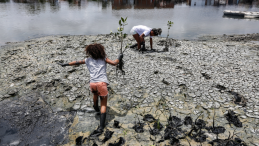Spatio-temporal Variation Trends of Mangrove Canopy Cover in Urban Areas Using Landsat 8 Imagery and Implications of Management Policies: A Case Study of the Benoa Bay Mangrove Area, Bali, Indonesia
Background: Mangroves are critical ecosystems that provide essential services, including coastal protection, biodiversity support, and carbon storage. However, urbanization and infrastructure development increasingly threaten their sustainability. This study investigates the spatio-temporal trends of mangrove canopy cover in Benoa Bay, Bali, Indonesia, which is an urban area and a center of tourism activities with various supporting facilities. The analysis was conducted from 2013 to 2023, using Landsat 8 satellite imagery and Normalized Difference Vegetation Index (NDVI) analysis. In addition, the analysis was also linked to mangrove area management policies.
Methods: The annual NDVI time series based on Landsat 8 imagery, obtained through the Google Earth Engine (GEE), was used to characterize the vegetation canopy cover in the study area. Statistical analysis of the annual linear trend of the NDVI was conducted to examine the spatio-temporal variation in canopy cover. Additionally, policies related to regional spatial planning and area protection were analyzed to assess their role in preserving mangrove forests in urban areas.
Results: There was a net decrease in mangrove area in Benoa Bay of 3.97 hectares, mainly due to infrastructure development and tourism facilities. The NDVI trend shows an overall increase in canopy cover due to reforestation and natural regeneration efforts, although there was a local decrease in some areas. Conservation policies, such as the establishment of the Ngurah Rai Forest Park, have supported mangrove protection.
Conclusions: The analysis demonstrated that mangroves surrounded by urban areas and tourism activity centers can still be maintained quite well with the right policies.
Related content




